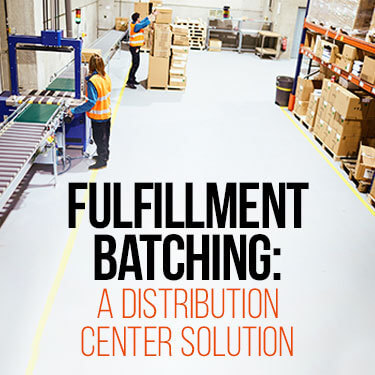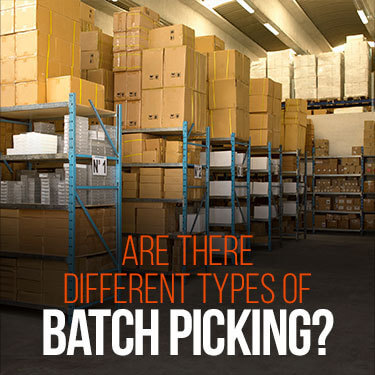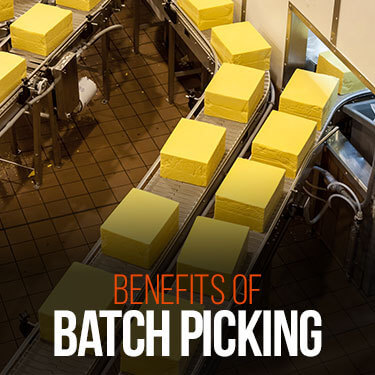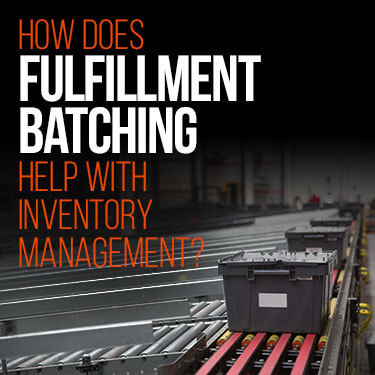
 Copy URL to Clipboard
Copy URL to Clipboard
Fulfillment batching is another method that warehouse managers are utilizing in their efforts to get orders filled quickly and correctly. Are you a warehouse manager seeking new ways to organize merchandise? Or an eCommerce business owner looking for solutions to expanding inventory needs? Get an in-depth look at fulfillment batching for your customers to see if it’s a good solution for you.
Fulfillment batching is an order picking method aimed at reducing employee travel time on the warehouse floor. An order management system groups identical or similar orders together in a “batch”. One picker can then fill several orders of the same items at the same time. Faster order processing may improve fulfillment time.
Learn how fulfillment batching is being used in warehouses to streamline pick & pack orders while improving customer satisfaction.
Table of Contents
Traditional warehouse organization and fulfillment services have been getting overhauled as eCommerce and online stores continue growing. Before, warehouses filled a majority of orders in bulk for distribution to major brick-and-mortar retailers. Small custom orders directly from warehouses were the exception rather than the norm.
Even before the Covid-19 pandemic that sent online sales skyrocketing, eCommerce businesses were starting to change the way warehouses operated. The boundaries of new technology were being pushed.
While there are different types of picking strategies used by warehouse managers, fulfillment batching is one of the most common. Also known as batch picking, it aims to optimize each picker's efficiency.
Fulfillment batching means organizing orders so that exact or similar orders are grouped together, creating a batch. One person can now easily complete multiple exact orders at the same time.
Like all picking strategies, its goal is to speed up the fulfillment process and minimize human errors. Much of the time, implementing a strategy is a top to bottom process. For warehouse managers and eCommerce business owners alike, this means you need to know the fulfillment process itself very well.

Within the fulfillment batching process, there are a few different methods. The method that works best for your business situation can and will vary.
In general, batch picking can be divided into three categories.
The size and complexity of your inventory and warehouse space may influence which strategy to use if you begin using batch pitching.
As with any fulfillment process, fulfillment batching starts with order processing. The moment someone finalizes their online order, the picking process begins.
There are two important programs that all warehouses should invest in for efficient processing.
Businesses and warehouses may be able to operate with only one of these systems. The downside is that there will be features sacrificed either way. Having an OMS only may deprive you of needed inventory management tools. If you choose a WMS for order processing, you may be giving up the ability to offer customers flexible payment systems and omnichannel experiences.
It might seem like overkill to have both for a small business, but as it grows, you’ll be glad you set the foundation for expansion early.
The OMS should be set up to create batches of orders that have the same or similar pick lists. Workers can use picking carts with bins to sort orders as they pick, or simply gather the needed number of each SKU (stock-keeping unit) and have the packers sort them into boxes. Both ways can be effective because they still aim to reduce travel time on the floor.
If you are using a good WMS as well, you can use collected shipment data trends to organize warehouse items accordingly. If items A and C are usually purchased together, then it makes sense to have them near each other in the warehouse. This feature contributes to the success of batch picking. For when workers do need to move to multiple sections, a WMS may be able to offer workers the best route to each item minimizing the total time needed.
Depending on what an online store is selling, putting fulfillment batching in place can be pretty easy. An online store selling medical scrubs may get frequent orders of light blue and navy shirt/pant combos.
| Order 1 | Order 2 | Order 3 |
| Light Blue Top: 3 | Light Blue Top: 1 | Light Blue Top: 2 |
| Light Blue Pant: 3 | Light Blue Pant: 1 | Light Blue Pant: 2 |
| Navy Top: 1 | Navy Top: 2 | |
| Navy Pant: 1 | Navy Pant: 2 |
Since all orders contain a variant of the same items, one person can gather them all. If you don’t want your pickers taking the time to sort, they can simply grab the needed items and place them in common bins.
Packers can sort these into their respective order boxes.
There may be the occasional order that goes against the grain, but data trends are usually a good indicator when studied over a length of time. In that case, pickers can still grab the bulk of the items and then go back for the outliers.
Regardless of the industry, online sales ordering and fulfillment follow similar steps. A simple breakdown can show you the major steps involved.
Average times for order fulfillment vary across the industry. If you are importing an order from abroad, it can take months. Online retailers within the United States have been trying to cut down total time to a few days. If you are living in a metropolitan area, you may even be able to get same-day or next-day delivery.
If you are working with a 3PL, they may already use a specific fulfillment system. In this case, you still want a good understanding of it how it affects your business.
Either way, faster delivery begins from the top. It won’t matter that your business is employing same-day delivery drones if you can’t get an order packed and ready.

There are a few ways to organize the batch picking process, but for all the goal is the same: improve picking rates to reduce processing times.
An efficient batch picking system will benefit companies and clients in many ways.
A process that can make warehouse fulfillment work for employees and customers is important. Current labor shortages in warehouses mean more stress for workers that are there. Fewer workers often translate to increased delivery times which may upset customers.
Providing a safe working environment for employees and giving them good training may help. Employees who feel secure with their skills for the job will be more confident and less prone to making mistakes.
Not all business and distribution models lend themselves easily to batch picking. For it to work well, a significant amount of prep work needs to be put in place. While not a direct disadvantage, if not done correctly it can create problems down the line.
Before switching to fulfillment batching strategies, warehouse managers and eCommerce owners should consider possible disadvantages.
Many of these disadvantages can be managed with strategic warehousing and employee training. Warehouse managers need to take a close and honest examination of their operation to determine if picking multiple items at once is even possible with their current setup.
Mistakes that create frequent returns will be costly and slow down all your logistics efforts.

When you begin using fulfillment batching, certain trends are going to become more apparent. Since this strategy requires investment into a good warehouse management system, you are going to be more aware of which products are getting consumed faster, slower, or not at all.
Merchandise ordering and restocking are then handled accordingly. Merchandise that isn’t selling, for example, is costing you money in storage fees. Perhaps the pricing for the item needs to be changed or you just need to find a way to liquidate it and make room for items that do sell.
Items that are frequently on backorder may do better if switched out of warehouse storage and into cross docking. You would be able to save on storage with the help of consolidation services.
Fulfillment batching is just one type of pick & pack service. Depending on the size and complexity, entire warehouses might be dedicated to only pick & pack services. Subscription box companies, as an example, may not have a need for bulk order processing. Everything is done with some kind of pick & pack service.
Other methods used instead of or together with batch picking include:
No single pick & pack method is always going to be better than another. The size of the operation along with peak season changes will make one solution better than another at times. If you plan on using one method exclusively, this is important to keep in mind. Although it can get complicated, planning for different pick & pack methods according to expected changes is possible.
Another option is outsourcing to a 3PL warehouse that can offer various fulfillment options. R+L Global Logistics has experience with multiple types of merchandise and can recommend the best fulfillment strategies for the situation.
Fulfillment logistics are complicated. Even with all the new technology at our disposal, finding the right solution may take some trial and error.
You can save yourself some of that hassle by partnering with R+L Global Logistics. We have the space and manpower to handle different fulfillment strategies. If we can’t do it, our warehouse consultants can help you find someone who can.
Whether you need fulfillment batching, custom order picking, or kitting services R+L Global is the right partner for the job. We also offer freight consolidation services.
Get a service quote today that’s tailored to your unique needs. You can also give us a call directly at (866) 989-3082 to speak with an R+L representative.
